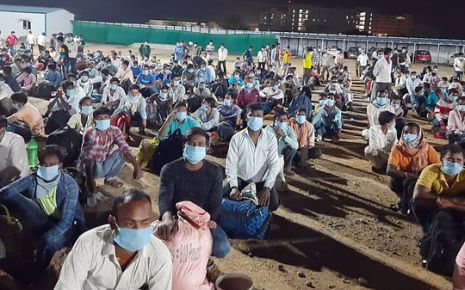Challenges And Opportunities In Implementing The New Labour Codes In India
In September 2020, the Indian government introduced a set of new labour codes,
aimed at consolidating and simplifying the country's existing labour laws. These
codes, which include the Code on Wages, the Industrial Relations Code, the
Occupational Safety, Health and Working Conditions Code, and the Social Security
Code, seek to provide comprehensive protection to workers while fostering a
conducive environment for businesses. However, the implementation of these codes
presents both challenges and opportunities for India's workforce and economy.
The Indian government's decision to consolidate 29 Central labour laws into 4 labour codes has been welcomed by several industry representatives, given that the move signalled a much-needed step towards reduced complexity and a simpler labour law regime which could benefit both employers and employees. While the move was welcomed and the intent commended, in the months that followed, the process of implementation resulted in certain gaps and unanswered questions coming to the surface, with the industry voicing some concerns over particular aspects and awaiting greater clarity.[1]
Challenges in Implementation
The successful implementation of the new labour codes faces several complex challenges that need to be addressed diligently. One of the primary hurdles is ensuring widespread awareness and understanding among both employers and employees. The codes bring about significant changes to the existing labour laws, including thresholds for lay-offs, closures and retrenchments, increase in gratuity and pay-outs, changes to payroll policies, etc., making effective dissemination of information vital to prevent confusion and potential non-compliance. To ensure that everyone is aware, proper channels for education and communication must be established.
While the new codes aim to simplify the regulatory framework, their effectiveness hinges on robust compliance mechanisms. Ensuring adherence to the provisions of the codes and enforcing them adequately, present considerable challenges, particularly in a country as vast and diverse as India. It requires a comprehensive approach involving training programs, inspections, and penalties for non-compliance to create a culture of compliance and accountability. Also, the inclusion of the informal sector, which constitutes a substantial part of India's economy, presents a unique challenge. The informal sector encompasses millions of workers engaged in low-skilled and often unregulated jobs.
Bringing this sector under the purview of the new labour codes requires overcoming various obstacles. These include the sector's sheer size, limited awareness among workers, and their resistance to change. Tailored strategies and outreach programs are necessary to ensure that the informal sector is not left behind in the implementation process.
Furthermore, striking a balance between worker protection and business interests is a delicate task. The new labour codes seek to harmonize worker rights with the aim of facilitating ease of doing business. However, this endeavour may encounter difficulties as businesses may resist certain provisions that increase costs or restrict operational flexibility. This resistance can lead to conflicts and prolonged negotiations, requiring careful consideration of the concerns of both workers and businesses to reach a fair and sustainable resolution.
The Code on Social Security introduces definitions for 'gig worker' and 'platform worker'. Gig workers refer to workers outside the "traditional employer-employee relationship". Platform workers are those who are outside the "traditional employer-employee relationship" and access organisations or individuals through an online platform and provide services.
The Code also defines unorganised workers which include self-employed persons. The Code creates provisions for different schemes for all these categories of workers (and defines the role that aggregators may be expected to play in some of these schemes)[2].
The categorization of gig workers, platform workers, and unorganized workers under the new labour codes may introduce some complexities and potential ambiguity in determining the eligibility of these workers for social security programs. There is a possibility of overlap between these categories, which could create confusion regarding the specific workers who qualify for such programs.
"Gig worker" and "platform worker" are concepts born in recent decades. Big corporations worked out a plan to bypass the labour laws globally and to minimise their liability concerning the rights of such workers. The gig economy used the carrot-and-stick approach to hire which means that the economy offered people things in order to persuade them to do something and then punish them if they refuse to do it. Similarly, informal sector workers were lured with higher incentives (Carrot-and-stick approach), which increased the standard of living of the workers and led them to take loans.
Finally, when the corporations lower the incentives, it makes the workers dependent which leads to bitterness among such workers.
The Code on Social Security 2020 does not clearly define benefits and entitlements for such workers (gig workers, platform workers, and unorganized workers). It doesn't provide a unified registration process and a compliance platform for all the said workers. The Standing Committee recommended that 'minimum entitlement' should be provided across various states for construction workers and unorganised workers to enable portability14, but it didn't see the light of the day.
Instead, we should consider thinking of implementing what the French entrepreneur Nicolas Colin calls "a new social contract", that would cover workers against the new risks of the day - the impossibility of renting housing in cities when your income is derived from gig platforms; access to loans when and where you need them, not necessarily to buy a car but instead to learn new skills when it's time to move on.[3]
In addition to the aforementioned issues, another challenge that emerges is the recognition of invisible labour. Unpaid work, commonly known as invisible labour, poses a significant concern. Jobs consisting of unpaid work such as childcare, household tasks, and elder care, disproportionately fall on women, constituting 90% of this unrecognized and unregulated work. Unfortunately, none of the new labour codes address the issue of invisible labour. These jobs entail arduous responsibilities without weekends off, fixed working hours, vacations, recognition, or compensation.
While considering the facts and figures, it must be noted that according to the report of the survey conducted by the National Statistical Office (NSO), which is a wing of the Ministry of Statistics and Programme Implementation in India, from January, 2019 to December, 2019 in its first Time Use Survey (TUS), 38.2 percent of persons who were of the age of six years or above were engaged in employment and related activities. As per the study, 57.3 percent of males were engaged in employment and related activities while the proportion was 18.4 percent for females in the country. Overall 53.2 percent of participants in the survey were engaged in unpaid domestic services for household members.
The challenges encountered by invisible labour have always been substantial, and the pandemic has further intensified these difficulties. While many enjoyed leisure time during lockdowns, unpaid workers faced increased household chores, lack of personal time, rest, and zero days off. The burden on invisible labour is compounded by the fact that their contributions often go unrecognized, making it a seemingly endless and an exhausting vicious race without a finish line[4].
Overall, addressing these challenges necessitates a multi-faceted approach that combines effective communication, robust compliance mechanisms, tailored strategies for the informal sector, and careful negotiation to strike the right balance between worker protection and business interests. By doing so, the implementation of the new labour codes can foster a more inclusive, compliant, and harmonious labour environment in India.
Opportunities for Advancement
The implementation of the new labour codes presents a significant opportunity to address the challenges and promote positive outcomes across various aspects of the labour ecosystem. One of the key benefits lies in the potential formalization of the informal sector. By extending legal protections and benefits to informal workers, such as access to social security and improved working conditions, the codes can enhance inclusivity and reduce income inequalities, leading to more equitable economic growth. Also, the consolidation of multiple labour laws into comprehensive codes can simplify compliance processes for businesses.
This streamlining, coupled with unified reporting mechanisms and digitalization initiatives, has the potential to significantly reduce the compliance burden, particularly for small and medium-sized enterprises (SMEs). Such measures can promote greater ease of compliance and contribute to a more efficient and supportive regulatory environment.
The new codes also prioritize flexibility at workplace, aiming to facilitate easier hiring and firing processes and promote contract work. This emphasis on flexibility can foster increased productivity and innovation, as businesses can swiftly adapt to changing market dynamics and optimize their workforce accordingly.
The codes thus recognize the importance of adaptability and agility in a rapidly evolving economic landscape. Also, the enforcement of the labour codes is emphasized, with labour inspectors now called 'inspectors-cum-facilitators', responsible for inspecting and advising employers and employees on compliance matters.
Employees have the right to directly approach courts on any matter under the Code on Wages, potentially leading to an increase in labour law litigation. Monetary penalties are prescribed for non-compliance, with imprisonment proceedings for repeated non-compliance by employers.
Moreover, the codes underscore the significance of skill development and social security for workers. By promoting training programs, apprenticeships, and portable benefits, the codes seek to enhance employability, provide financial security, and encourage lifelong learning. These initiatives acknowledge the need for workers to continually upgrade their skills in response to technological advancements and shifting job requirements, ultimately fostering a more resilient and empowered workforce.
Essentially, the implementation of the new labour codes holds promise for formalizing the informal sector, simplifying compliance processes, promoting flexibility and productivity, and facilitating skill development and social security. By addressing these aspects comprehensively, the codes can aim to create a more inclusive, adaptable, and sustainable labour environment.
Conclusion
The implementation of the new labour codes in India presents a mixed bag of challenges and opportunities. While there are complexities to be addressed in terms of awareness, compliance, and balancing worker rights with business interests, the codes offer an unprecedented chance to reform the labour ecosystem.
The Periodic Labour Force Survey Report (2018-19) indicates that 70% of regular wage or salaried employees in the non-agricultural sector did not have a written contract, and 52% did not have any social security benefit. Also, as per the NITI (National Institute for Transforming India) Aayog, which is the apex public policy think tank of the Government of India, the existing labour laws framework does not encourage the growth of labour intensive sectors as a matter of scheme or arrangement.
These laws need to be reviewed in such a manner that it introduces an element of incentive for greater labour absorption. The Four new Labour codes which are yet to be implemented address the issues at hand.[5] By effectively addressing these challenges and leveraging the opportunities at hand, India can strive towards achieving a more inclusive, productive, and equitable labour market for the benefit of its workers and the overall economy.
End-Notes:
The Indian government's decision to consolidate 29 Central labour laws into 4 labour codes has been welcomed by several industry representatives, given that the move signalled a much-needed step towards reduced complexity and a simpler labour law regime which could benefit both employers and employees. While the move was welcomed and the intent commended, in the months that followed, the process of implementation resulted in certain gaps and unanswered questions coming to the surface, with the industry voicing some concerns over particular aspects and awaiting greater clarity.[1]
Challenges in Implementation
The successful implementation of the new labour codes faces several complex challenges that need to be addressed diligently. One of the primary hurdles is ensuring widespread awareness and understanding among both employers and employees. The codes bring about significant changes to the existing labour laws, including thresholds for lay-offs, closures and retrenchments, increase in gratuity and pay-outs, changes to payroll policies, etc., making effective dissemination of information vital to prevent confusion and potential non-compliance. To ensure that everyone is aware, proper channels for education and communication must be established.
While the new codes aim to simplify the regulatory framework, their effectiveness hinges on robust compliance mechanisms. Ensuring adherence to the provisions of the codes and enforcing them adequately, present considerable challenges, particularly in a country as vast and diverse as India. It requires a comprehensive approach involving training programs, inspections, and penalties for non-compliance to create a culture of compliance and accountability. Also, the inclusion of the informal sector, which constitutes a substantial part of India's economy, presents a unique challenge. The informal sector encompasses millions of workers engaged in low-skilled and often unregulated jobs.
Bringing this sector under the purview of the new labour codes requires overcoming various obstacles. These include the sector's sheer size, limited awareness among workers, and their resistance to change. Tailored strategies and outreach programs are necessary to ensure that the informal sector is not left behind in the implementation process.
Furthermore, striking a balance between worker protection and business interests is a delicate task. The new labour codes seek to harmonize worker rights with the aim of facilitating ease of doing business. However, this endeavour may encounter difficulties as businesses may resist certain provisions that increase costs or restrict operational flexibility. This resistance can lead to conflicts and prolonged negotiations, requiring careful consideration of the concerns of both workers and businesses to reach a fair and sustainable resolution.
The Code on Social Security introduces definitions for 'gig worker' and 'platform worker'. Gig workers refer to workers outside the "traditional employer-employee relationship". Platform workers are those who are outside the "traditional employer-employee relationship" and access organisations or individuals through an online platform and provide services.
The Code also defines unorganised workers which include self-employed persons. The Code creates provisions for different schemes for all these categories of workers (and defines the role that aggregators may be expected to play in some of these schemes)[2].
The categorization of gig workers, platform workers, and unorganized workers under the new labour codes may introduce some complexities and potential ambiguity in determining the eligibility of these workers for social security programs. There is a possibility of overlap between these categories, which could create confusion regarding the specific workers who qualify for such programs.
"Gig worker" and "platform worker" are concepts born in recent decades. Big corporations worked out a plan to bypass the labour laws globally and to minimise their liability concerning the rights of such workers. The gig economy used the carrot-and-stick approach to hire which means that the economy offered people things in order to persuade them to do something and then punish them if they refuse to do it. Similarly, informal sector workers were lured with higher incentives (Carrot-and-stick approach), which increased the standard of living of the workers and led them to take loans.
Finally, when the corporations lower the incentives, it makes the workers dependent which leads to bitterness among such workers.
The Code on Social Security 2020 does not clearly define benefits and entitlements for such workers (gig workers, platform workers, and unorganized workers). It doesn't provide a unified registration process and a compliance platform for all the said workers. The Standing Committee recommended that 'minimum entitlement' should be provided across various states for construction workers and unorganised workers to enable portability14, but it didn't see the light of the day.
Instead, we should consider thinking of implementing what the French entrepreneur Nicolas Colin calls "a new social contract", that would cover workers against the new risks of the day - the impossibility of renting housing in cities when your income is derived from gig platforms; access to loans when and where you need them, not necessarily to buy a car but instead to learn new skills when it's time to move on.[3]
In addition to the aforementioned issues, another challenge that emerges is the recognition of invisible labour. Unpaid work, commonly known as invisible labour, poses a significant concern. Jobs consisting of unpaid work such as childcare, household tasks, and elder care, disproportionately fall on women, constituting 90% of this unrecognized and unregulated work. Unfortunately, none of the new labour codes address the issue of invisible labour. These jobs entail arduous responsibilities without weekends off, fixed working hours, vacations, recognition, or compensation.
While considering the facts and figures, it must be noted that according to the report of the survey conducted by the National Statistical Office (NSO), which is a wing of the Ministry of Statistics and Programme Implementation in India, from January, 2019 to December, 2019 in its first Time Use Survey (TUS), 38.2 percent of persons who were of the age of six years or above were engaged in employment and related activities. As per the study, 57.3 percent of males were engaged in employment and related activities while the proportion was 18.4 percent for females in the country. Overall 53.2 percent of participants in the survey were engaged in unpaid domestic services for household members.
The challenges encountered by invisible labour have always been substantial, and the pandemic has further intensified these difficulties. While many enjoyed leisure time during lockdowns, unpaid workers faced increased household chores, lack of personal time, rest, and zero days off. The burden on invisible labour is compounded by the fact that their contributions often go unrecognized, making it a seemingly endless and an exhausting vicious race without a finish line[4].
Overall, addressing these challenges necessitates a multi-faceted approach that combines effective communication, robust compliance mechanisms, tailored strategies for the informal sector, and careful negotiation to strike the right balance between worker protection and business interests. By doing so, the implementation of the new labour codes can foster a more inclusive, compliant, and harmonious labour environment in India.
Opportunities for Advancement
The implementation of the new labour codes presents a significant opportunity to address the challenges and promote positive outcomes across various aspects of the labour ecosystem. One of the key benefits lies in the potential formalization of the informal sector. By extending legal protections and benefits to informal workers, such as access to social security and improved working conditions, the codes can enhance inclusivity and reduce income inequalities, leading to more equitable economic growth. Also, the consolidation of multiple labour laws into comprehensive codes can simplify compliance processes for businesses.
This streamlining, coupled with unified reporting mechanisms and digitalization initiatives, has the potential to significantly reduce the compliance burden, particularly for small and medium-sized enterprises (SMEs). Such measures can promote greater ease of compliance and contribute to a more efficient and supportive regulatory environment.
The new codes also prioritize flexibility at workplace, aiming to facilitate easier hiring and firing processes and promote contract work. This emphasis on flexibility can foster increased productivity and innovation, as businesses can swiftly adapt to changing market dynamics and optimize their workforce accordingly.
The codes thus recognize the importance of adaptability and agility in a rapidly evolving economic landscape. Also, the enforcement of the labour codes is emphasized, with labour inspectors now called 'inspectors-cum-facilitators', responsible for inspecting and advising employers and employees on compliance matters.
Employees have the right to directly approach courts on any matter under the Code on Wages, potentially leading to an increase in labour law litigation. Monetary penalties are prescribed for non-compliance, with imprisonment proceedings for repeated non-compliance by employers.
Moreover, the codes underscore the significance of skill development and social security for workers. By promoting training programs, apprenticeships, and portable benefits, the codes seek to enhance employability, provide financial security, and encourage lifelong learning. These initiatives acknowledge the need for workers to continually upgrade their skills in response to technological advancements and shifting job requirements, ultimately fostering a more resilient and empowered workforce.
Essentially, the implementation of the new labour codes holds promise for formalizing the informal sector, simplifying compliance processes, promoting flexibility and productivity, and facilitating skill development and social security. By addressing these aspects comprehensively, the codes can aim to create a more inclusive, adaptable, and sustainable labour environment.
Conclusion
The implementation of the new labour codes in India presents a mixed bag of challenges and opportunities. While there are complexities to be addressed in terms of awareness, compliance, and balancing worker rights with business interests, the codes offer an unprecedented chance to reform the labour ecosystem.
The Periodic Labour Force Survey Report (2018-19) indicates that 70% of regular wage or salaried employees in the non-agricultural sector did not have a written contract, and 52% did not have any social security benefit. Also, as per the NITI (National Institute for Transforming India) Aayog, which is the apex public policy think tank of the Government of India, the existing labour laws framework does not encourage the growth of labour intensive sectors as a matter of scheme or arrangement.
These laws need to be reviewed in such a manner that it introduces an element of incentive for greater labour absorption. The Four new Labour codes which are yet to be implemented address the issues at hand.[5] By effectively addressing these challenges and leveraging the opportunities at hand, India can strive towards achieving a more inclusive, productive, and equitable labour market for the benefit of its workers and the overall economy.
End-Notes:
- Understanding India's New Labour Codes: Challenges In Implementation, Mondaq, 26 May 2021
- Overview of Labour Law Reforms
- Emerging Challenges in Labour Laws, January 2022, Manupatra
- Ibid.
- Ibid.
Law Article in India
Legal Question & Answers
Lawyers in India - Search By City
LawArticles
How To File For Mutual Divorce In Delhi

How To File For Mutual Divorce In Delhi Mutual Consent Divorce is the Simplest Way to Obtain a D...
Increased Age For Girls Marriage

It is hoped that the Prohibition of Child Marriage (Amendment) Bill, 2021, which intends to inc...
Facade of Social Media

One may very easily get absorbed in the lives of others as one scrolls through a Facebook news ...
Section 482 CrPc - Quashing Of FIR: Guid...

The Inherent power under Section 482 in The Code Of Criminal Procedure, 1973 (37th Chapter of t...
The Uniform Civil Code (UCC) in India: A...

The Uniform Civil Code (UCC) is a concept that proposes the unification of personal laws across...
Role Of Artificial Intelligence In Legal...

Artificial intelligence (AI) is revolutionizing various sectors of the economy, and the legal i...








Please Drop Your Comments